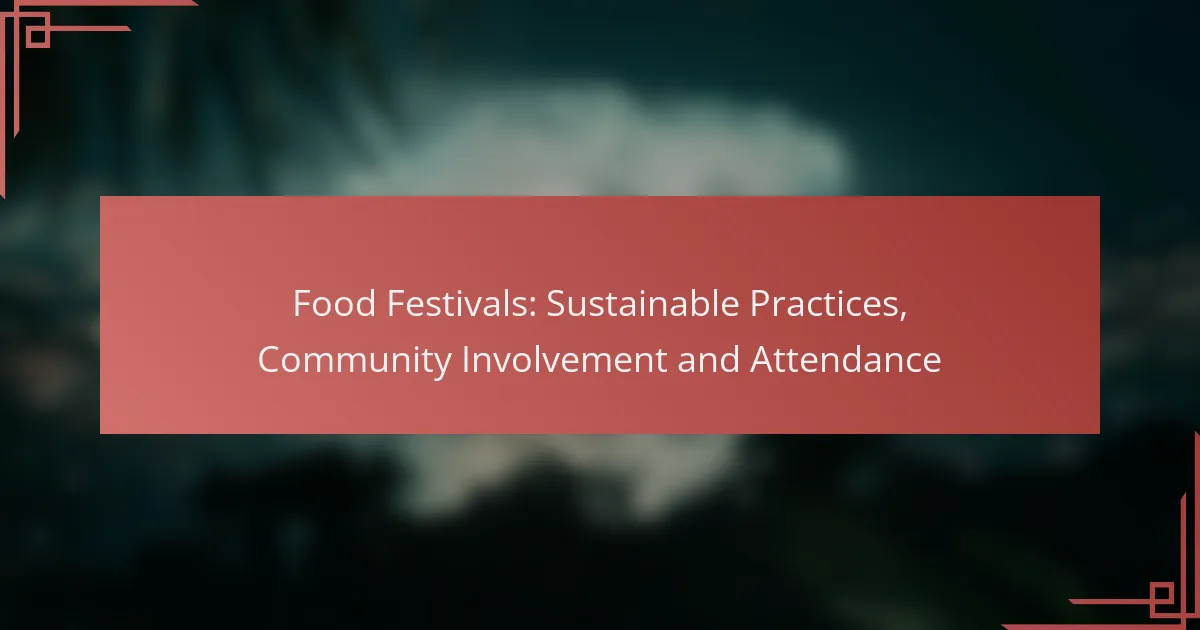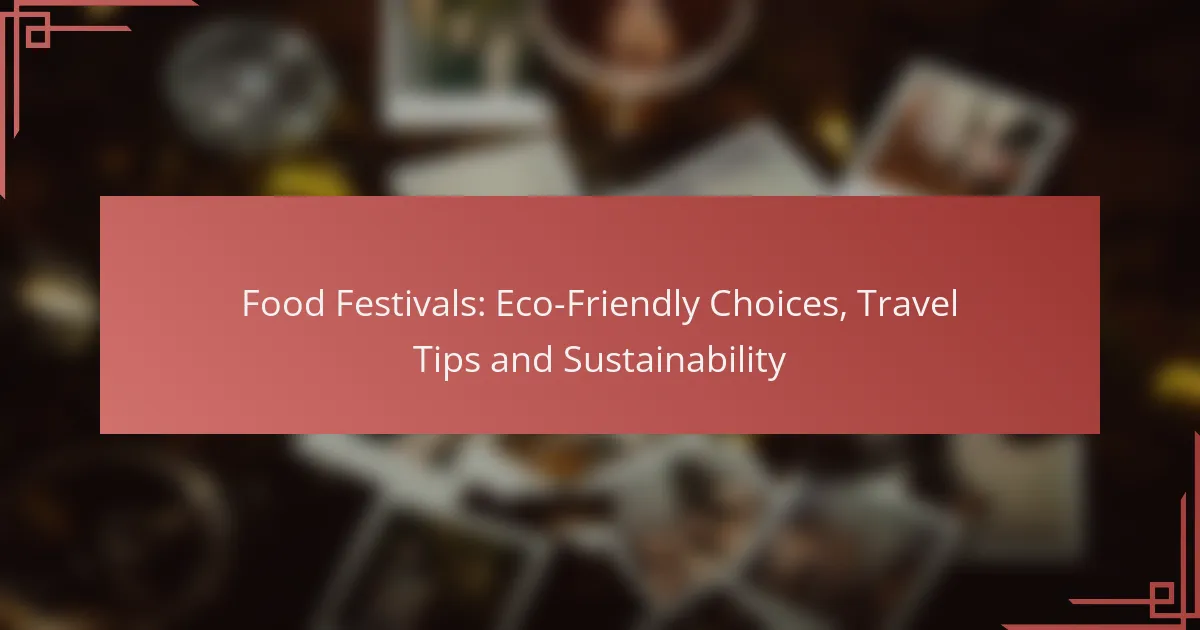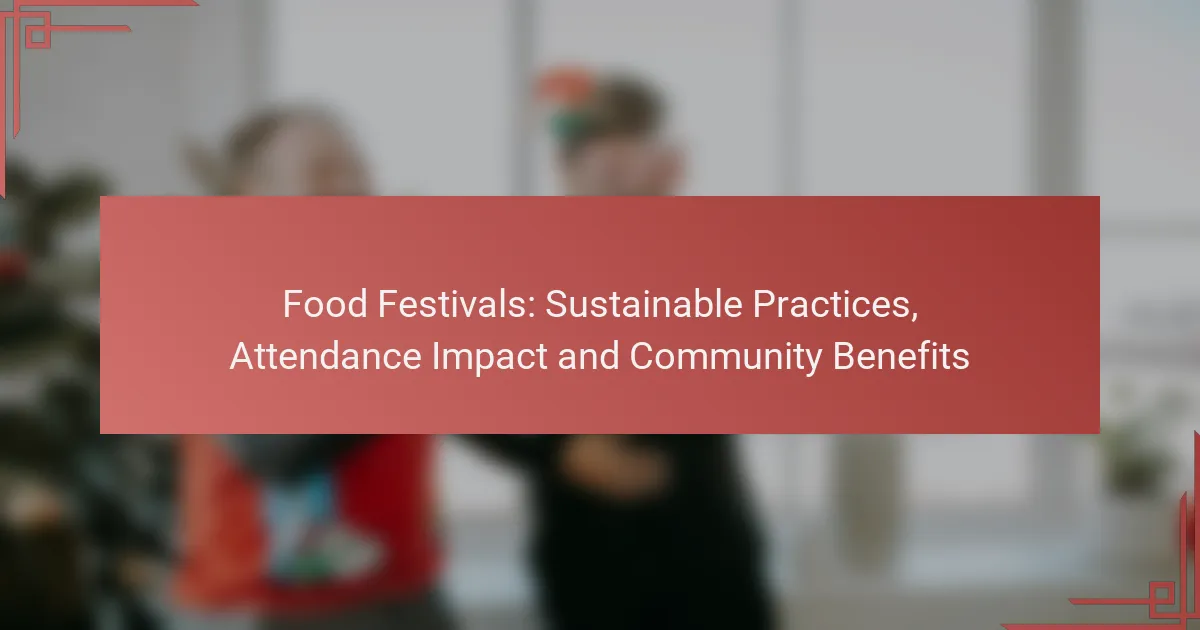Food festivals serve as a vibrant platform for promoting sustainable practices while fostering community involvement. By implementing initiatives such as waste reduction and local sourcing, these events not only minimize environmental impact but also enhance the festival experience through active participation from community members. With effective marketing and partnerships, organizers can boost attendance, creating a lively atmosphere that benefits both attendees and local businesses.
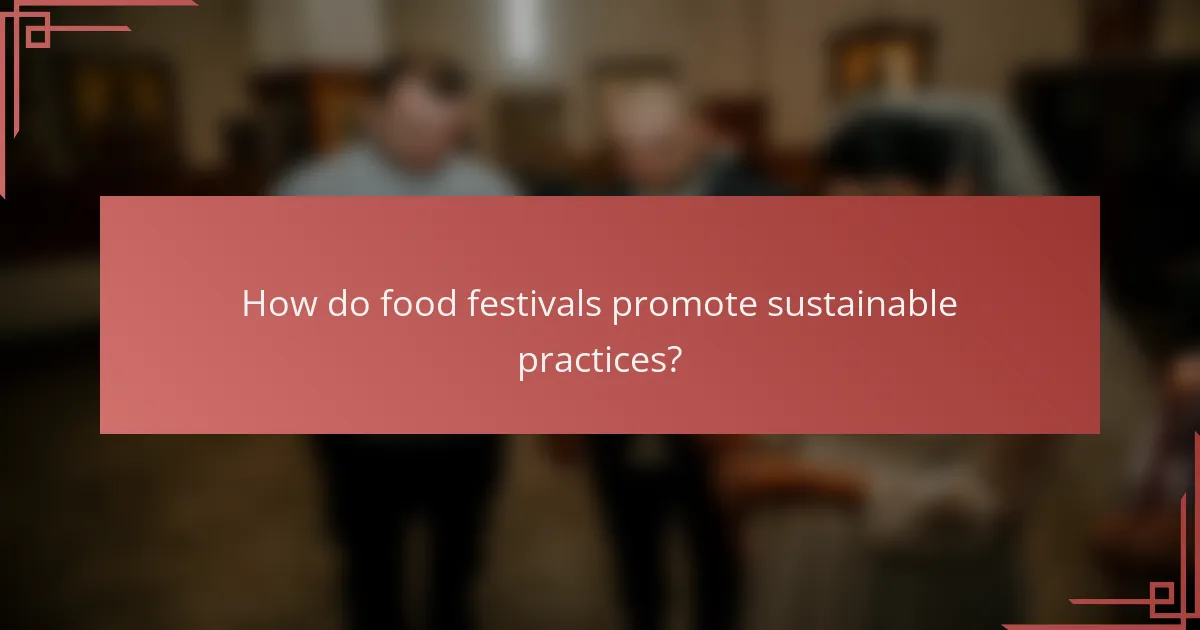
How do food festivals promote sustainable practices?
Food festivals promote sustainable practices by implementing initiatives that minimize environmental impact while fostering community engagement. These events often focus on waste reduction, local sourcing, eco-friendly packaging, and carbon offset programs to create a more sustainable food culture.
Waste reduction initiatives
Waste reduction initiatives at food festivals aim to minimize food waste and promote recycling. Many festivals partner with local organizations to donate surplus food to shelters or food banks, ensuring that excess food is not wasted. Additionally, some festivals implement composting programs to recycle organic waste.
To effectively reduce waste, festivals can encourage vendors to participate in waste audits and set specific waste reduction goals. This can include strategies like offering smaller portion sizes or providing incentives for vendors who successfully minimize their waste output.
Local sourcing of ingredients
Local sourcing of ingredients is a key practice for enhancing sustainability at food festivals. By prioritizing local farmers and producers, festivals reduce transportation emissions and support the regional economy. This practice also ensures that attendees enjoy fresher, seasonal food options.
Festivals can promote local sourcing by featuring a “farm-to-festival” theme, where vendors highlight their partnerships with local suppliers. This not only educates attendees about the benefits of local food but also encourages them to seek out local products in their everyday lives.
Eco-friendly packaging solutions
Eco-friendly packaging solutions are essential for minimizing waste at food festivals. Many festivals encourage vendors to use biodegradable or compostable materials instead of traditional plastics. This shift helps reduce the amount of non-recyclable waste generated during the event.
Festivals can provide guidelines for vendors on acceptable packaging materials and may even offer bulk purchasing options for eco-friendly supplies. Additionally, implementing a “no single-use plastic” policy can further promote sustainable practices among both vendors and attendees.
Carbon offset programs
Carbon offset programs help food festivals mitigate their carbon footprint by investing in projects that reduce greenhouse gas emissions. These programs can include tree planting initiatives, renewable energy projects, or community-based sustainability efforts.
Festivals can calculate their carbon emissions and set a target for offsetting a portion of those emissions through partnerships with environmental organizations. This not only enhances the festival’s sustainability credentials but also raises awareness among attendees about the importance of reducing carbon footprints in their own lives.
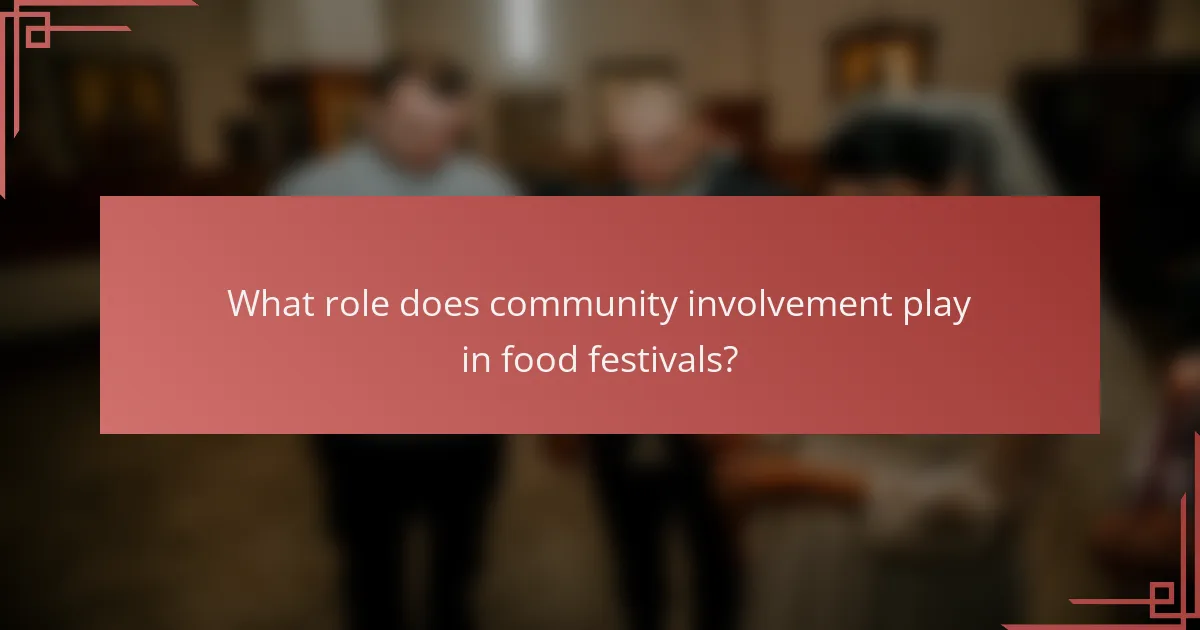
What role does community involvement play in food festivals?
Community involvement is crucial for the success of food festivals, as it fosters local engagement and enhances the festival experience. By actively participating, community members contribute to the festival’s atmosphere, support local businesses, and promote sustainable practices.
Local chef collaborations
Local chef collaborations are a key aspect of food festivals, showcasing regional culinary talent and ingredients. Chefs often partner with local farms and producers to create unique dishes that reflect the area’s flavors. This not only supports the local economy but also encourages sustainable sourcing practices.
For example, a food festival might feature a “farm-to-table” dinner where local chefs prepare meals using ingredients sourced from nearby farms. This collaboration highlights the importance of community connections in promoting both culinary excellence and sustainability.
Volunteer opportunities for residents
Food festivals often rely on volunteers from the community to help with various tasks, such as setting up, managing booths, and assisting attendees. These volunteer opportunities allow residents to engage directly with the festival while gaining valuable experience and skills. It also fosters a sense of ownership and pride in the event.
Residents interested in volunteering should check the festival’s website for sign-up details, as many festivals offer incentives like free admission or meal vouchers for volunteers. This creates a win-win situation, benefiting both the festival and the community members involved.
Community-sponsored events
Community-sponsored events within food festivals can include cooking demonstrations, workshops, and cultural performances that highlight local traditions. These events encourage participation from various community groups, enriching the festival experience and promoting cultural exchange.
For instance, a food festival might host a local cooking competition where residents can showcase their culinary skills, with winners receiving prizes or recognition. Such events not only entertain but also strengthen community ties and celebrate local heritage.

How can attendance at food festivals be increased?
Increasing attendance at food festivals can be achieved through targeted marketing, community engagement, and effective partnerships. By focusing on these areas, organizers can attract more visitors and create a vibrant atmosphere that benefits everyone involved.
Effective marketing strategies
Utilizing a mix of traditional and digital marketing strategies is crucial for boosting attendance. Local newspapers, radio stations, and community bulletin boards can help reach a broader audience, while online ads and email newsletters can target specific demographics.
Creating eye-catching promotional materials, such as posters and flyers, can also draw attention. Special offers, such as early bird ticket discounts or group rates, can incentivize potential attendees to commit to attending the festival.
Partnerships with local businesses
Collaborating with local businesses can enhance the festival’s appeal and increase attendance. Restaurants, farms, and food producers can showcase their products, creating a sense of community and shared purpose.
Offering sponsorship opportunities to local businesses can also provide financial support for the festival while promoting their brand. In return, businesses can offer discounts or promotions to festival attendees, encouraging more people to participate.
Engaging social media campaigns
Social media is a powerful tool for increasing attendance at food festivals. Creating engaging content, such as behind-the-scenes videos, chef interviews, and sneak peeks of featured dishes, can generate excitement and anticipation.
Utilizing hashtags and encouraging attendees to share their experiences can further amplify the festival’s reach. Running contests or giveaways on platforms like Instagram and Facebook can also incentivize sharing and attract a larger audience.

What are the benefits of attending food festivals?
Attending food festivals offers numerous benefits, including the chance to experience diverse culinary delights, connect with others in the food community, and support local economies. These events foster a vibrant atmosphere where food lovers can explore new flavors while contributing to their local culture and economy.
Culinary exploration
Food festivals provide an excellent opportunity for culinary exploration, allowing attendees to taste a wide variety of dishes from different cultures and regions. Visitors can sample everything from gourmet street food to artisanal products, often prepared by local chefs and vendors.
Many festivals also feature cooking demonstrations and workshops, where participants can learn new techniques and recipes. This hands-on experience enhances appreciation for the culinary arts and encourages attendees to try new ingredients and cooking styles at home.
Networking opportunities
Food festivals are ideal for networking, bringing together chefs, food producers, and enthusiasts. Attendees can meet industry professionals, share ideas, and build relationships that may lead to collaborations or job opportunities.
Engaging with others who share a passion for food can also lead to lasting friendships and connections within the community. Many festivals encourage interaction through workshops, tastings, and panel discussions, fostering a sense of camaraderie among participants.
Support for local economies
By attending food festivals, individuals directly support local economies. These events often feature local vendors, farmers, and artisans, providing them with a platform to showcase their products and reach new customers.
Moreover, food festivals can attract tourists, boosting local businesses such as hotels, restaurants, and shops. This influx of visitors can significantly benefit the community, creating jobs and enhancing the overall economic landscape.

What criteria should be considered when choosing a food festival?
When selecting a food festival, consider factors such as location, accessibility, the festival’s theme and offerings, and its community reputation. These elements can significantly influence your overall experience and satisfaction.
Location and accessibility
The location of a food festival is crucial for convenience and enjoyment. Look for festivals that are easily reachable by public transport or have ample parking options. Festivals in urban areas may offer more accessibility compared to those in remote locations.
Consider the surrounding amenities as well. Nearby accommodations, dining options, and attractions can enhance your visit, especially if you plan to stay overnight or explore the area further.
Festival theme and offerings
The theme of a food festival can greatly impact your experience, as it dictates the types of cuisine and activities available. For instance, a festival focused on local farm-to-table practices will feature different offerings compared to one centered on international street food.
Review the festival’s lineup of vendors and activities before attending. Look for diverse food options, cooking demonstrations, and workshops that align with your interests. This will help ensure that the festival meets your culinary expectations.
Community reputation
The reputation of a food festival within the community can provide valuable insights into its quality and organization. Research past attendee reviews and feedback to gauge the overall satisfaction of previous visitors.
Engaging with local social media groups or forums can also yield recommendations and warnings about specific festivals. A well-regarded festival often reflects a commitment to sustainability and community involvement, enhancing the overall experience for attendees.
